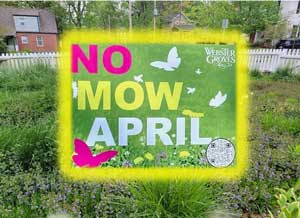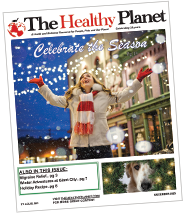
By Jean Ponzi
Webster Groves Goes NO MOW
It started in the UK in 2019, blew like dandelions across Wisconsin towns, and sprouted this spring on traditionally trim suburban lawns of Webster Groves.
The No Mow movement aims to nourish emerging pollinators in a practical, generous, grounded way.
Up north, this means No Mow May. Prime time here is April for violets, creeping charlie, clover and other “weeds” in our turf to do their (hen)bit until the trees flower. These humble plants continue to serve bees and other insects well into the warming weeks when our flower beds bloom – if we do not mow them down.
How did this shadow side of spiffy seed conscientious Webster?
“The goal of No Mow April,” reports Jen Starkey, the city’s Director of Public Affairs and Engagement, “was, simply, THINK ABOUT IT. Think outside the box of conventional lawn making your place a good neighbor.”
Eco-logical citizens led the charge, but the city’s beloved parks had opened the way. Parks Director Yvonne Steingrube has been integrating native landscaping into parks and roadways for several years. Skillful – and cost-saving – transformation of significant park acreage from strictly turf and ornamental plantings to emphasis on native planted areas, set a trend.
“Our parks show how turf alternatives can improve stormwater management and provide wildlife refuge,” says Starkey. “Not as simple as just avoiding mowing, but that’s a start. People have been appreciating native plant habitats in the parks, as we continue to enjoy our mowed playing fields and walking areas.”
Beyond the parks, in council chambers, No Mow April champions pitched in. City Council member Emily Hixson Shepherd led the move to suspend Webster’s turf-height and weed ordinances for the month. Green Space Commissioners Lynnda Green, Corin Pursell and Carrie Coyne teamed up to secure essential local media coverage from the Webster-Kirkwood Times, host a monthly speaker series, moderate the social media exchange, and generally problem-solve. Starkey created a webpage, yard sign order form and (very important) Resident Feedback Form for www.webstergrovesmo.com.
With 408 registered participants, No Mow April’s first year exceeded expectations. Starkey’s initial order of 150 spring-pink signs were out in yards in the first three days. “We distributed 350 signs,” she says, “and we could have used more. People in neighboring communities called wanting signs. Save Your Sign is our slogan now, anticipating next year.”
Online registration offered residents choices:
- No mow at all
- Leave nesting sites for bees
- Add native plants to your property
You could opt for No Mow in your front or back yard, or both. Households were responsible for notifying their landscaping contractors. Highly visible, big-property owners participated too: Eden Seminary and Webster University.
As Starkey delivered the signs, she could often tell from a distance which address she was going to, so many homes already had beds of native plants. Every month for these folks was already No Mow!
Starkey reports largely positive feedback: Thank you all for your love of pollinators. We just helped them get the best start they’ve had in decades!
With a few sharp critiques: I personally think this was a horrible idea by the city. Let’s get things cleaned up.
Residents also shared Green intentions: My five-year plan is to extend the garden beds until there is only a path of grass left and then add large flagstone to the path.
At the end of April, the project team circulated thanks – and expert guidelines for resuming mowing, shared by the horticulture staff of St. Louis Community College. This post included an invitation:
Before you decide to mow your lawn at the end of the month, grab your lawn chair and a cool drink. Take some time to enjoy the sights and sounds of the habitat you created. Do you really need all that turf? Perhaps you could add more garden beds filled with native perennials, groundcovers, shrubs, and trees. We aren’t suggesting you remove your entire lawn all at once. Perhaps a phased transition from lawn to garden space. It’s something to think about!
Through the rolling acres of Webster Groves, No Mow April may have seeded a grassroots revelation.
You can read more about No Mow April in the Missouri Botanical Garden blog, www.DiscoverAndShare.org, and check out Jean Ponzi’s KDHX Earthworms podcast conversations relating to native plants at earthworms.kdhxtra.org.


